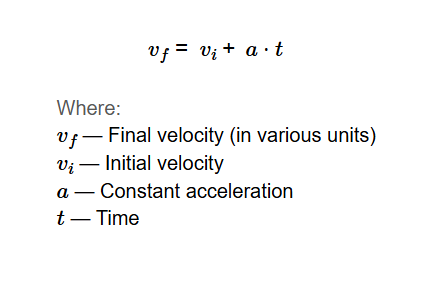 Home
Home
 Back
Back

Definition: This calculator computes the final velocity (\( v_f \)) of an object under constant acceleration based on its initial velocity (\( v_i \)), acceleration (\( a \)), and time (\( t \)).
Purpose: It is used in physics to determine the velocity of an object after a given time under constant acceleration, applicable in motion analysis, vehicle dynamics, and projectile motion.
The calculator uses the relationship:
Where:
Explanation: Enter the initial velocity, acceleration, and time in the chosen units, and the calculator computes the final velocity. Results are displayed with 5 decimal places, using scientific notation if the value exceeds 100,000 or is less than 0.0001. For default inputs (\( v_i = 0 \, \text{m/s} \), \( a = 2 \, \text{m/s}^2 \), \( t = 5 \, \text{s} \)), the calculated final velocity \( v_f \) is 10.00000 m/s.
Details: Calculating velocity with constant acceleration is essential for analyzing the motion of objects under uniform acceleration, aiding in the design of vehicles, simulations, and motion control systems.
How do I find the final velocity with constant acceleration?
Measure the initial velocity in meters/second, the acceleration in meters/second², and the time in seconds. Compute the final velocity using the formula \( v_f = v_i + a \cdot t \). The result will be in meters/second.
What does final velocity represent?
Final velocity represents the speed and direction of an object after a given time under constant acceleration, starting from its initial velocity.
What is the formula for velocity with constant acceleration?
The formula for velocity with constant acceleration is \( v_f = v_i + a \cdot t \), where \( v_i \) is the initial velocity, \( a \) is the acceleration, and \( t \) is the time. The standard unit for velocity is meters/second (m/s).